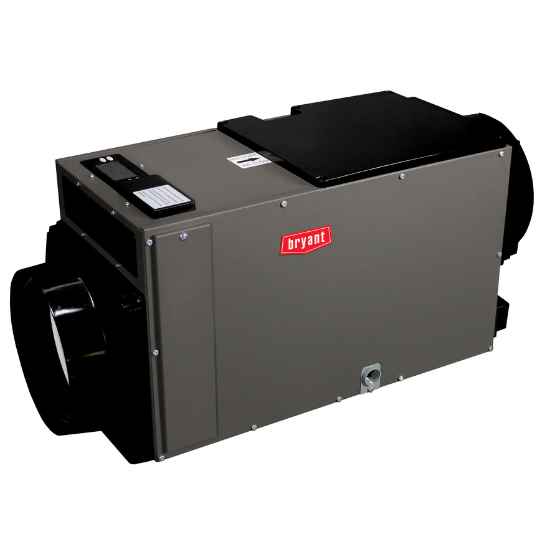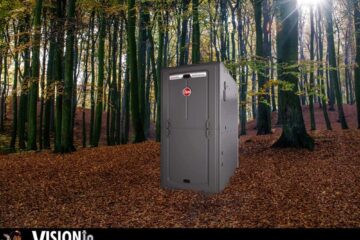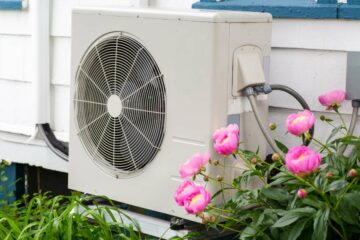
As the temperature drops, people throughout the Okanagan start closing windows and turning on the heat. This simple change, however, can have a big impact on the air we breathe inside our homes. Fall brings a unique set of indoor air quality (IAQ) challenges, from circulating allergens, to the discomfort of dry air.
At Vision Plumbing Heating Cooling, we’ve spent decades helping Kelowna families create healthier, more comfortable living spaces. Here’s our guide to understanding and improving your indoor air quality this fall.
Why Your Home’s Air Quality Changes in the Fall
After being dormant all summer, your furnace is about to get a workout. When you fire it up, it can blow dust, mould spores, and other allergens that have settled in your ductwork throughout your home. This is especially important in the Okanagan, where our summers involve dealing with wildfire smoke and its effects on indoor air quality. As we close up our homes to keep the cold out, we also trap these lingering pollutants indoors, raising their concentration.
On top of that, the crisp fall air tends to have lower humidity. When your furnace heats this dry air, it becomes even drier, leading to a host of uncomfortable issues.
Fall’s Two Biggest Air Quality Problems
1. Allergens and Irritants
Even if you don’t have allergies, you might notice more sneezing, coughing, or a stuffy nose as the seasons change. Here’s what’s behind it:
- Pollen and Mould: Ragweed pollen is a big fall allergen, and it can easily sneak into your home on clothes or pets. Falling leaves and moisture also create perfect conditions for outdoor mould, which can then find its way inside.
- Dust Mites: These tiny pests thrive in humid summer conditions, but once your furnace kicks in, their dried-up remains get stirred up and circulated.
- Pet Dander: As your pets spend more time indoors, dander can build up in carpets and upholstery, becoming a constant source of allergens.
2. The Discomfort of Dry Air
When your home’s humidity drops below the ideal range of 30-50%, you can experience a number of problems:
- Physical Discomfort: You might notice dry, itchy skin, chapped lips, or a sore throat.
- Increased Illness: Dry nasal passages are less effective at filtering out viruses, making you more vulnerable to colds and flu.
- Damage to Your Home: Low humidity can cause wood floors, furniture, and plaster to crack, and even create annoying static electricity shocks. See our tips on preventing humidity damage to hardwood floors.
Your Best Defence: Solutions for Better Indoor Air
Improving your home’s air quality is about more than just feeling better—it’s about protecting your health and your home. Here are our top solutions.
DIY Solutions
- Change Your Furnace Filter: This is the simplest and most effective step you can take. A clean filter ensures good airflow and traps larger airborne particles. We recommend changing it every 1-3 months during the heating season. For more maintenance tips, check out our blog on fall furnace tune-up tips.
- Vacuum with a HEPA Filter: Use a vacuum with a HEPA filter to effectively remove allergens from carpets and upholstery.
- Dust Regularly: Pay attention to hidden spots where dust loves to settle, like behind furniture and on top of appliances.
- Check for Air Leaks: Ensure windows, doors, and other entry points are properly sealed to prevent outdoor allergens from getting in.
H3: Professional Solutions
Professional indoor air quality services are often the most sure-fire way to improve the air you and your family breathe every day.
- Whole-Home Humidifiers: The most effective way to combat dry air is with a humidifier that integrates with your furnace. Unlike portable units, a whole-home system adds moisture to the air as it circulates, providing consistent humidity throughout your entire house.
- Advanced Air Filtration: Standard furnace filters are designed to protect the equipment, not to clean your air. Upgrading to a higher-MERV filter or a professional air purifier can capture a much wider range of particles, like mould spores, pet dander, and fine dust.
- Electric Air Cleaners (EACs): These are whole-home air purifiers installed in your HVAC system. EACs use electrically charged plates to trap tiny airborne contaminants like dust, pollen, pet dander, mould spores, and smoke (including particles as small as 0.1 microns). Many models also include carbon filters to help reduce odours. These systems are quiet, require minimal maintenance, and can improve your HVAC system’s efficiency by reducing dust buildup on its components.
Ready for a Healthy Winter?
You deserve to be comfortable at home. By taking proactive steps like changing your filter, to considering a professional IAQ system, you can create a healthier, more comfortable home for your family.
At Vision Plumbing Heating Cooling, we’re here to help you breathe easy. Our experts can assess your home and recommend the right indoor air quality solutions, from whole-home humidifiers to advanced air purifiers.
Ready to improve your home’s air? Contact us today to schedule a consultation.
Fall Indoor Air Quality FAQs
The most effective way to combat dry air is with a whole-home humidifier. Unlike portable units that only humidify a single room, a whole-home system integrates with your furnace to add moisture to the air as it is distributed throughout your entire home, providing consistent and balanced humidity levels.
For optimal indoor air quality, you should change your furnace filter every 1 to 3 months. If you have pets, allergy sufferers in your home, or notice a lot of dust, it’s best to change it closer to the one-month mark.
Yes, a professional furnace tune-up can significantly improve your home’s air quality. During a tune-up, a technician cleans the system’s interior components, including the blower and burners, which helps reduce the amount of dust and debris circulated through your home’s ductwork. This also ensures your furnace is operating efficiently.
Poor indoor air quality can contribute to a variety of health issues, including allergies, asthma symptoms, respiratory infections, and even chronic fatigue. Pollutants like dust, mould, smoke, and pet dander can trigger these symptoms, while dry air can make you more susceptible to illness.
An Electronic Air Cleaner (EAC) is a whole-home air purifier installed in your HVAC system’s ductwork. It uses electrically charged plates to attract and trap tiny airborne particles like dust, pollen, pet dander, and smoke, making the air that circulates through your home cleaner and healthier.




